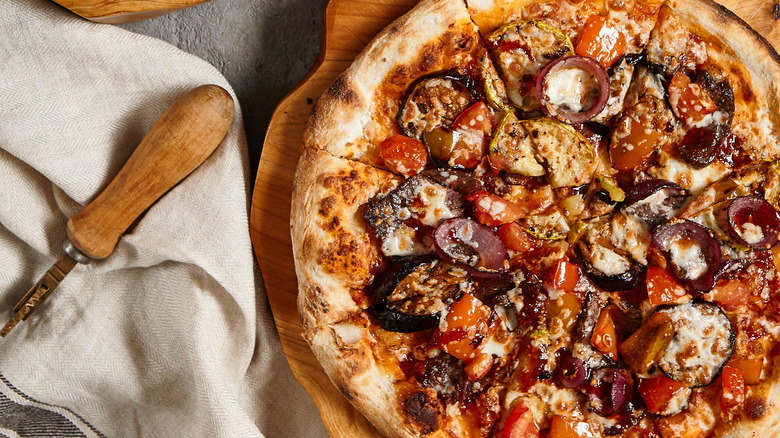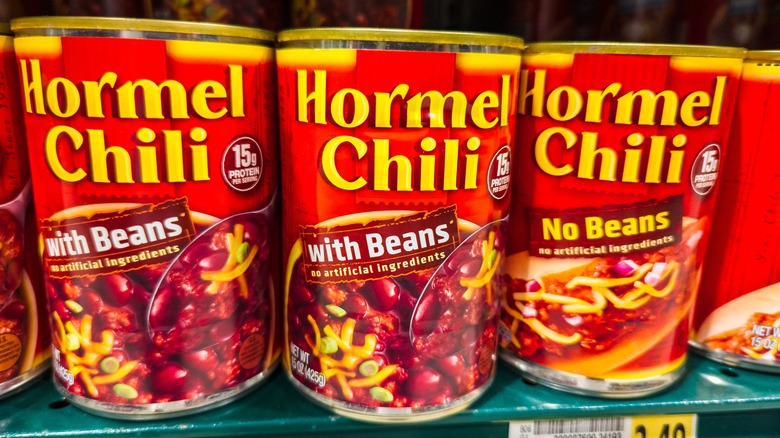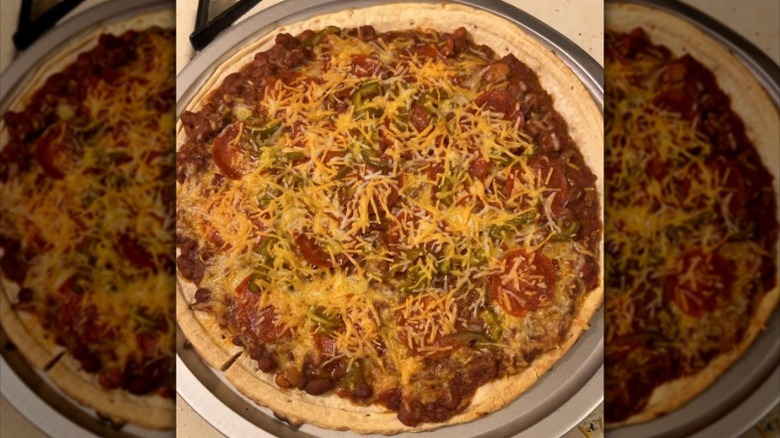No Pizza Sauce, No Problem — Grab This Canned Pantry Hero
So it's homemade pizza night, and you've got the crust, cheese, and toppings ready to go, but whoops! Looks like you're out of pizza sauce. Sure, you can always make it from scratch, but what if you don't have any canned tomatoes? No need to fuss, Frank Katabas, who owns and operates Manhattan's East Village Pizza, has a suggestion to throw out there: Why not open up a can of chili?
"Using canned chili as a substitute for pizza sauce can be great if handled correctly. Canned chili can bring an interesting flavor profile to your pizza," Katabas told The Takeout. He did offer a caveat, however, saying: "Canned chili should be treated like a sauce, rather than a topping. This helps to give the pizza the chili flavor, without drowning the pizza in extra liquid." In his professional experience, he feels that any good pizza (be it homemade or otherwise) needs moisture control to prevent it from becoming soggy. He also opined, "The chili should act as a flavor support, rather than the main event, to ensure balance."
How to put together a chili-based pizza
Frank Katabas advised, "It's important to be mindful of the consistency of the canned chili you are using. Sometimes, canned chili can be on the heavier/thicker side, and other times, it can be thinner. It's important to find the right balance so that you do not drown the pizza dough if using the full can." He suggested starting with just two or three tablespoons for a 12-inch pizza. The key word is "start," however. If this amount seems skimpy to you (Sunny Anderson's 1-2-3 pizza rule calls for a full cup of sauce, after all), you can always add more. If the chili is on the thin side, though, drain off the excess liquid or simmer it until it thickens.
Katabas doesn't endorse any specific brand, noting: "It's more about the texture and the consistency of the chili. Everyone has different preferences. People can use whichever brand or style of canned chili they would like, as long as it's not too thin for the pizza." (If you do want a recommendation, our reviewer favors Campbell's Chunky Chili with Beans, while I've always been partial to Hormel.)
As for the crust, Katabas says that traditional pizza crust, pita, or naan could all work with chili as a base, depending on the preparation and cook time. He added: "One tip to make sure it stands up to canned chili is to use cheese to create a barrier to protect the crust from becoming soggy. To do this, simply sprinkle a light layer of cheese first, apply the chili, then add more cheese on top."
What toppings work with a chili pizza?
"Chili is a versatile ingredient that can pair well with other flavors to make for a uniquely delicious homemade pizza," Frank Katabas declared. But how to top it? Sure, you can go with the standard mozzarella cheese, but cheddar or pepper jack might work even better to complement the chili's flavor. You could then extend the theme even further by adding standard chili-type toppings such as chopped onions, sliced jalapeños, sour cream, or even a sprinkling of crushed tortilla chips.
Katabas also suggested making a chili cheese dog pie, which might be even better if you're using Coney-style hot dog chili rather than chili with beans. The chili would be the sauce, while the cheese layer would be made up of a combination of cheddar and mozzarella, and sliced hot dogs and onions could serve as the toppings. If you want to dress the pizza up after it's baked, you could also add a drizzle of mustard.
Katabas also floated the idea of making a chili-buffalo chicken pizza hybrid. (That's three Super Bowl favorites in one!) The way he'd make it would be to use either ranch or blue cheese dressing as the bottom sauce layer, topped by chili, with mozzarella cheese and shredded buffalo chicken on top. As he sees it, "This would balance the heat of the buffalo, the flavors of the chili, and the creaminess from the dressing, all without compromising the integrity of the crust."


